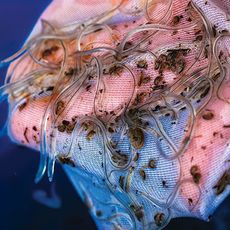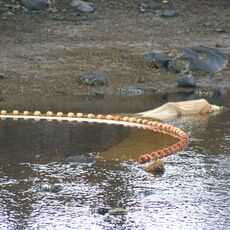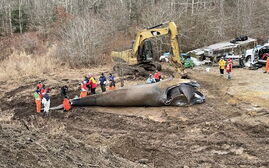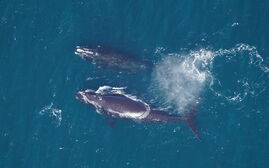
With quota intact, Maine’s lucrative baby eel fishery dodges a multimillion-dollar bullet
 File photo / David Clough
In this 2016 file photo from the Mainebiz archives, Patricia and Paul Bryant tend their nets during a dawn trip to a favored river spot in Bristol.
File photo / David Clough
In this 2016 file photo from the Mainebiz archives, Patricia and Paul Bryant tend their nets during a dawn trip to a favored river spot in Bristol.
Maine’s lucrative fishery for baby eels — also called elvers or glass eels, depending on their stage of maturity — has escaped a proposed harvest cut that could have decimated the market.
At its meeting earlier this month, the Atlantic States Marine Fisheries Commission’s American Eel Board decided against a 21.8% reduction in Maine’s maximum catch to an annual quota of 7,576 pounds.
Instead, the board retained the current quota of 9,688 pounds.
In 2022, the most recent year where data is available, Maine's elver fishery had a value of $20.16 million, up from $16.7 million in 2021, according to the Department of Marine Resources. The baby eels are typically shipped to aquaculture facilities in Asia, where they are grown and processed for restaurants and food purveyors.
A reduction of the maximum catch “would have been an economic loss of millions of dollars for Maine’s elver fishery,” Patrick Keliher, commissioner of the Maine Department of Marine Resources, said in a message to the industry posted on the department’s website on Friday.
Keliher continued, “Fortunately, the board recognized the strong management measures we’ve instituted here in Maine to avoid exceeding the state’s allotted quota and to reduce the incidents of illegal harvesting.

Surveys by the department show that, over five of the last seven years, the baby eel population has “significantly” exceeded the average annual survey catch since 2001, he said.
Keliher added, “Bottom line, this is great news for a fishery that, last year, generated over $20 million dollars for fishermen.”
The deliberations were part of Draft Addendum VI to the commission’s Interstate Fishery Management Plan for American Eel. The board initiated the addendum last August to address the Maine commercial quota for glass eel starting in the 2025 fishing season.
It also contains options for how long the 9,688-pound quota should stay in place.
The current quota expires at the end of 2024. The options allowing the quota to stay in place until it’s modified through the fishery management planning process, or sunseting the quota in three years, from 2025 through 2027.
The proposed measures come in response to stock assessment findings that the American eel stock is depleted to historically low levels. The addendum considers reducing the harvest of baby eels, which grow into adult eels, and reducing the adult eel harvest.
A complex path
The commission has coordinated interstate management of the American eel fishery since 2000. The management unit is defined as the portion of the American eel population occurring in the territorial seas and inland waters, up to 3 miles offshore, from Maine to Florida.
Management authority in the exclusive economic zone from 3 miles to 200 miles from shore lies with the National Marine Fisheries Service.
The American eel spawns in the ocean and migrates to fresh water to grow to adult size. As adult eels mature, they leave the brackish growing areas in the fall, migrate to the Sargasso Sea and spawn during the late winter. The Sargasso Sea is a large area of the western North Atlantic located east of the Bahamas and south of Bermuda.
After spawning, the adult eels die. The eggs hatch after several days and develop into larvae drift, which drift in the ocean for several months and then enter the Gulf Stream current to be carried toward North America.
As they approach the continental shelf, the larvae transform into miniature transparent eels called "glass eels." When they leave the open ocean to enter estuaries and ascend rivers they are known as elvers.
The migration occurs in late winter, early spring and throughout the summer. The elvers grow into adult eels, which stay in growing areas from eight to 25 years before migrating back to sea to spawn.
Maine money-maker

Maine’s baby eel fishery harvests the tiny creatures as they return to rivers from their ocean spawning areas. The fishery utilizes fine mesh fyke nets — a funnel-shaped net — or dip nets to collect elvers as they ascend to fresh water.
The babies are generally shipped to aquaculture facilities in Asia, where they are grown to adult size, then processed for the food market.
In Maine, the fishing season for elvers runs from March 22 through June 7, although the fishery may be closed earlier if Maine's quota, as established by the commission, has been met.
The Department of Marine Resources held lotteries for elver licenses until 2013, when the Legislature suspended them because of the state quota. In 2017, the Legislature authorized the Department of Marine Resources to renew the lottery but capped total licenses at 425.
Department staff monitor the elver fishery to collect information on the harvest and fishing effort, bycatch of other species in elver nets, and the impact of this fishery on adult eel abundance in Maine waters. In addition, the department has funded a number of eel research projects with the University of Maine at Orono to investigate various life history aspects of the American eel.
Although the eel fishery has a long history in Maine, elver fishing is relatively recent.
It began in the early 1970s as a low-key, sporadic, but worthwhile operation for anywhere from a handful of fishermen to a couple of thousand, at times, attracted to earning as much as several hundred dollars per pound for the Asian market.
The fishery took a dramatic due to intensified demand from Asia stemming from declines in the European stocks that Asian eel farmers had been using.
A price boom dating back to 2010 had a Wild West-like start characterized by pickup truck dealings and cash transactions of tens of thousands of dollars. New regulations were implemented to sustain legitimate harvesting for continued export.
In 2012, Maine’s glass eel landings hit an all-time high of 21,610 pounds with a landed value of over $38 million. The huge spike in price per pound brought with it poaching problems and there was a call to close the fishery.
Over the next two years, the Department of Marine Resources responded by instituting a voluntary reduction in harvest of 35% from the 18,076 pounds that was landed in 2013. That established the first glass eel quota for Maine at 11,749 pounds. The quota was subsequently cut another 11%, reducing Maine’s glass eel quota to 9,688 pounds.
Since the implementation of the 9,688-pound glass eel quota, landings have tracked closely with the quota. The exception was 2015, when a late spring with ice and high water contributed to a drop in landings to 5,260 pounds.













0 Comments